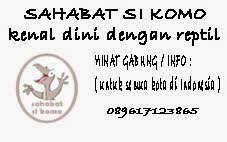T-REC
Semarang-komunitas-reptil-semarang-CITES-convention-on-international-trade-in-endangered-species-of-wild-fauna-and-flora-valid
from 12 june 2013-appendix 1-sekilas-tentang-buaya-nil- Nile crocodile- Crocodylus niloticus
- CITES…………valid from 12June 2013
- CLASS REPTILIA ( REPTILES )
- FAMILY : Crocodylidae
( Crocodiles )
- Crocodylus niloticus
- Appendix : 1
-
Note : Except
the populations of Botswana, Egypt (subject to a zero quota for wild specimens
traded for commercial purposes), Ethiopia, Kenya, Madagascar, Malawi,
Mozambique, Namibia, South Africa, Uganda, the United Republic of Tanzania (subject
to an annual export quota of no more than 1,600 wild specimens including
hunting trophies, in addition to ranched specimens), Zambia and Zimbabwe, which
are included in Appendix II
Kecuali
populasi di
Botswana, Mesir (dikenakan
nol kuota untuk spesimen
liar yang diperdagangkan untuk tujuan komersial), Ethiopia, Kenya,
Madagaskar, Malawi, Mozambik, Namibia, Afrika Selatan, Uganda, Republik Tanzania
(tergantung kuota ekspor tahunan tidak lebih dari 1.600 spesimen liar
termasuk untuk
trofi berburu, selain spesimen
ranched), Zambia dan
Zimbabwe, yang termasuk dalam Lampiran
II
Nile
crocodile
From
Wikipedia, the free encyclopedia
The Nile crocodile (Crocodylus niloticus) is
an African crocodile and
the second largest extant reptile in the world, after the saltwater crocodile. The Nile crocodile is
quite widespread throughout sub-saharan Africa, occurring
mostly in the central, eastern and southern parts of the continent and lives in
different types of aquatic environments such as lakes, rivers and marshlands.
Taxonomy and etymology
The binomial name Crocodylus niloticus is derived from the Greek kroko ("pebble"), deilos ("worm", or "man"), referring to its rough skin; and niloticus, meaning "from the Nile River". The Nile crocodile is called timsah al-nil in Arabic, mamba in Swahili, garwe in Shona, ngwenya in Ndebele, ngwena in Venda, kwena in Sotho and Tswana.Size
The Nile crocodile is the largest crocodilian
in Africa and is
the second-largest crocodilian after the saltwater crocodile.
Distribution and habitat
The Nile crocodile is the most common crocodilian found in Africa today. They are common throughout the continent. Their historic range however, was even wider. They were found as north as the Mediterranean coast in the Nile delta. Today they are common in Somalia, Ethiopia, Uganda, Kenya, Egypt, Tanzania, Burundi, Zambia, Zimbabwe, Gabon, South Africa, Malawi, Sudan, South Sudan, Botswana, and Cameroon. Isolated populations also exist in Madagascar and in Senegal.
The IUCN Red List assesses the Nile crocodile as
"Least Concern (LR/lc)". The
CITES
lists the Nile crocodile under Appendix I (threatened with extinction) in most
of its range; and under Appendix II (not threatened, but trade must be
controlled) in the remainder, which either allows ranching or sets an annual
quota of skins taken from the wild. This species is farmed for its meat
and leather in some parts of Africa.
Class:
|
|
Clade:
|
|
Order:
|
|
Family:
|
|
Subfamily:
|
|
Genus:
|
|
Species:
|
C.
niloticus
|
Nile
crocodile
From
Wikipedia, the free encyclopedia
Nile crocodile (Crocodylus niloticus) adalah buaya
Afrika dan reptil yang terbesar
kedua di dunia, setelah buaya air asin. Penyebaran cukup
luas di seluruh sub-Sahara Afrika, terutama di, bagian timur dan selatan tengah benua dan
tinggal di berbagai jenis lingkungan
perairan seperti danau, sungai
dan rawa.
Taksonomi dan etimologi
Nama binomial Crocodylus niloticus berasal dari kroko Yunani ("kerikil"), deilos ("cacing", atau "manusia"), mengacu pada kulit yang kasar, dan niloticus, yang berarti "dari Sungai Nil". disebut Timsah al-nihil dalam bahasa Arab, mamba dalam bahasa Swahili, garwe di Shona, Ngwenya di Ndebele, ngwena di Venda, Kwena di Sotho dan Tswana.
ukuran
adalah buaya terbesar di Afrika dan merupakan buaya terbesar kedua setelah buaya air asin.
Distribusi dan habitat
adalah buaya yang paling umum ditemukan di Afrika hari ini. umum di seluruh benua. bahkan lebih luas. Mereka ditemukan di utara pantai Mediterania di delta Nil. umum di Somalia, Ethiopia, Uganda, Kenya, Mesir, Tanzania, Burundi, Zambia, Zimbabwe, Gabon, Afrika Selatan, Malawi, Sudan, Sudan Selatan, Botswana, dan Kamerun. juga ada di Madagaskar dan di Senegal.
Daftar Merah IUCN menilai buaya Nil sebagai " Least Concern (LR / lc)". CITES terdaftar di bawah Lampiran I (terancam punah) di sebagian besar jangkauan, dan di bawah Appendix II (tidak terancam, namun perdagangan harus dikendalikan) , baik di peternakan atau menetapkan kuota tahunan kulit yang diambil dari alam. Spesies ini biasa diambil daging dan kulit di beberapa bagian Afrika.
Class:
|
|
Clade:
|
|
Order:
|
|
Family:
|
|
Subfamily:
|
|
Genus:
|
|
Species:
|
C.
niloticus
|
sumber















